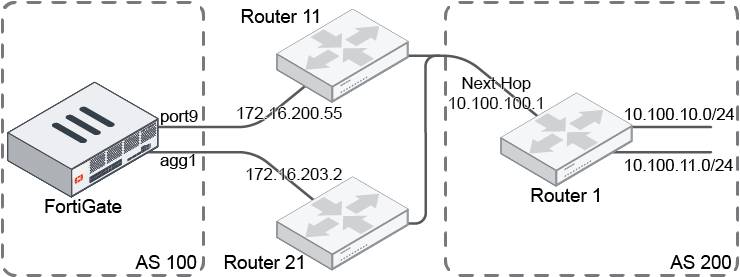ECMP routes for recursive BGP next hop resolution
When there are multiple ECMP routes to a BGP next hop, all of them are considered for the next hop recursive resolution. This ensures that the outgoing traffic can be load balanced.
|
|
To support multipath, either EGBP or IGBP multipath must be enabled: config router bgp
set ebgp-multipath enable
set ibgp-multipath enable
end
|

In this example, there are two static routes. The FortiGate has learned two BGP routes from Router 1 that have the same next hop at 10.100.100.1. The next hop is resolved by the two static routes.
To verify that the routes are added to the BGP routing table:
-
Check the two static routes:
# get router info routing-table static Routing table for VRF=0 S 10.100.100.0/24 [10/0] via 172.16.200.55, port9 [10/0] via 172.16.203.2, agg1 -
Confirm that both routes are in the BGP routing table:
# get router info routing-table bgp Routing table for VRF=0 B 10.100.10.0/24 [20/200] via 10.100.100.1 (recursive via 172.16.200.55, port9), 00:00:07 (recursive via 172.16.203.2, agg1), 00:00:07 B 10.100.11.0/24 [20/200] via 10.100.100.1 (recursive via 172.16.200.55, port9), 00:00:07 (recursive via 172.16.203.2, agg1), 00:00:07

